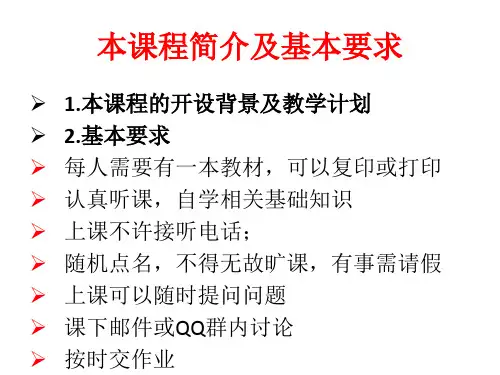数理经济学-数理经济学本086jok-48页文档资料
- 格式:ppt
- 大小:318.50 KB
- 文档页数:48
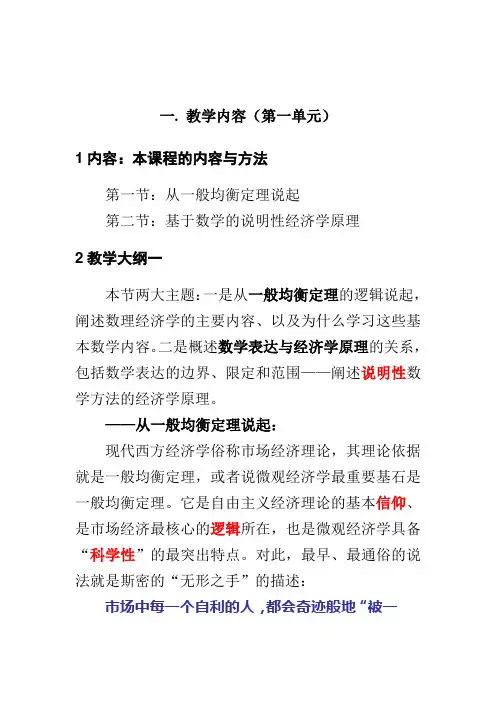
一. 教学内容(第一单元)1内容:本课程的内容与方法第一节:从一般均衡定理说起第二节:基于数学的说明性经济学原理2教学大纲一本节两大主题:一是从一般均衡定理的逻辑说起,阐述数理经济学的主要内容、以及为什么学习这些基本数学内容。
二是概述数学表达与经济学原理的关系,包括数学表达的边界、限定和范围——阐述说明性数学方法的经济学原理。
——从一般均衡定理说起:现代西方经济学俗称市场经济理论,其理论依据就是一般均衡定理,或者说微观经济学最重要基石是一般均衡定理。
它是自由主义经济理论的基本信仰、是市场经济最核心的逻辑所在,也是微观经济学具备“科学性”的最突出特点。
对此,最早、最通俗的说法就是斯密的“无形之手”的描述:市场中每一个自利的人,都会奇迹般地“被一只无形之手所引导,致力于一种与其真实的主观意愿并不相同的、效率的目标”、“这种由于追求自己的利益,却经常促进了社会的利益,其效果比他真正想要促进社会利益所能达到的效果还要大”。
一般均衡定理:在一个具有一般商品的完全竞争性交易的经济体里,存在一个关于一般商品的价格,使得一般商品的市场供需能够保持平衡。
(图一)数学描述见图一的映射表达,见图形说明。
形式说明:一个社会的参与人只有两类:消费者和生产者;一般商品的概念,具体只有三类:劳动、资本和商品。
行为只有一种模式:交换(生产简化为资本、劳动与商品的交换;消费即投入商品与产出劳动力的过程,价格向量为利率、工资和单位商品比率)。
——其他人、其他行为哪去了?结论内涵:一般均衡理论包含两个子命题:一是均衡存在性,二是效率最优性。
给出了命题——假设条件(完全竞争、完全信息)、逻辑途径(市场交易)及逻辑结论(稳定的价格均衡)!给出了一个社会的最简单经济结构图景问题1、什么是市场行为?有什么本质特征?不需要神的统治,就存在一种人人都行为自由、人人满意的社会,是一种理想国的理想世界状态。
自由的含义:自由进入(完全竞争)、自主经营、自愿交易、自担风险(收益最大化理性)。
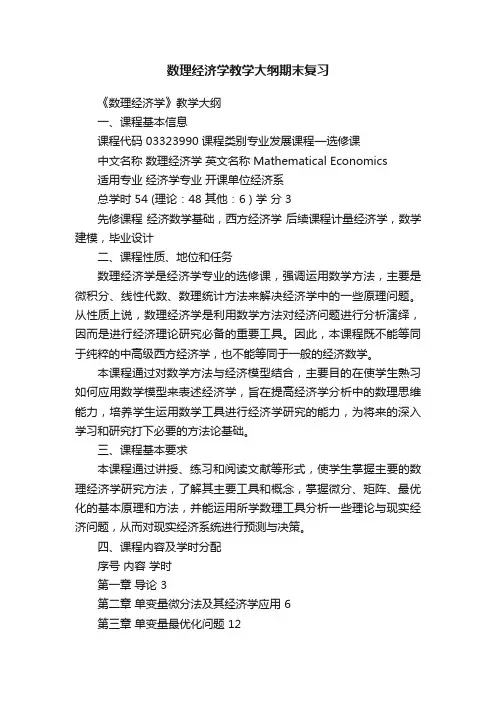
数理经济学教学大纲期末复习《数理经济学》教学大纲一、课程基本信息课程代码 03323990 课程类别专业发展课程—选修课中文名称数理经济学英文名称Mathematical Economics适用专业经济学专业开课单位经济系总学时 54 (理论:48 其他:6 ) 学分 3先修课程经济数学基础,西方经济学后续课程计量经济学,数学建模,毕业设计二、课程性质、地位和任务数理经济学是经济学专业的选修课,强调运用数学方法,主要是微积分、线性代数、数理统计方法来解决经济学中的一些原理问题。
从性质上说,数理经济学是利用数学方法对经济问题进行分析演绎,因而是进行经济理论研究必备的重要工具。
因此,本课程既不能等同于纯粹的中高级西方经济学,也不能等同于一般的经济数学。
本课程通过对数学方法与经济模型结合,主要目的在使学生熟习如何应用数学模型来表述经济学,旨在提高经济学分析中的数理思维能力,培养学生运用数学工具进行经济学研究的能力,为将来的深入学习和研究打下必要的方法论基础。
三、课程基本要求本课程通过讲授、练习和阅读文献等形式,使学生掌握主要的数理经济学研究方法,了解其主要工具和概念,掌握微分、矩阵、最优化的基本原理和方法,并能运用所学数理工具分析一些理论与现实经济问题,从而对现实经济系统进行预测与决策。
四、课程内容及学时分配序号内容学时第一章导论 3第二章单变量微分法及其经济学应用 6第三章单变量最优化问题 12第四章线性模型与矩阵代数 9第五章多变量微分法及其经济学应用 12第六章多变量最优化问题 12合计 54第一章导论【教学内容】数理经济学的概念、数理经济学的起源和发展、数理经济学的研究对象、研究方法。
【教学基本要求】通过本章的学习,使学生了解数理经济学的产生和发展、数理经济学的研究方法,理解经济模型的构成及其作用。
【教学安排】课堂讲授3学时【重难点】数理经济学的研究方法、经济模型第一节数理经济学的产生和发展第二节数理经济学的研究方法第三节经济模型第二章单变量微分法及其经济学应用【教学内容】连续函数,导数和微分,经济学中的“边际”概念,反函数,经济学中的增长率【教学基本要求】复习单变量微分法基本数学原理;掌握经济学中各种函数连续性及其可微性;深刻认识边际、弹性与增长率的概念,理解它们与微分之间的关系。
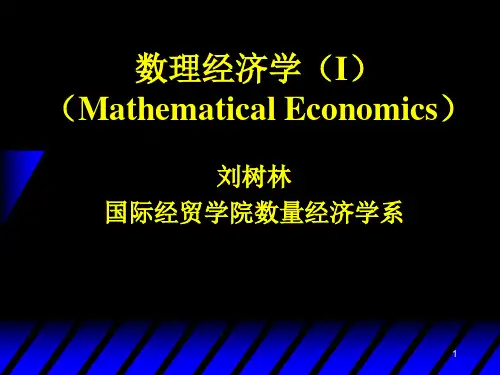


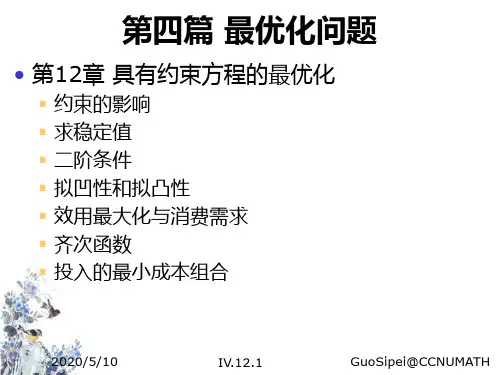
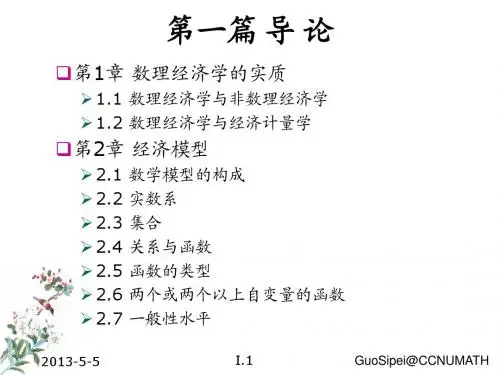
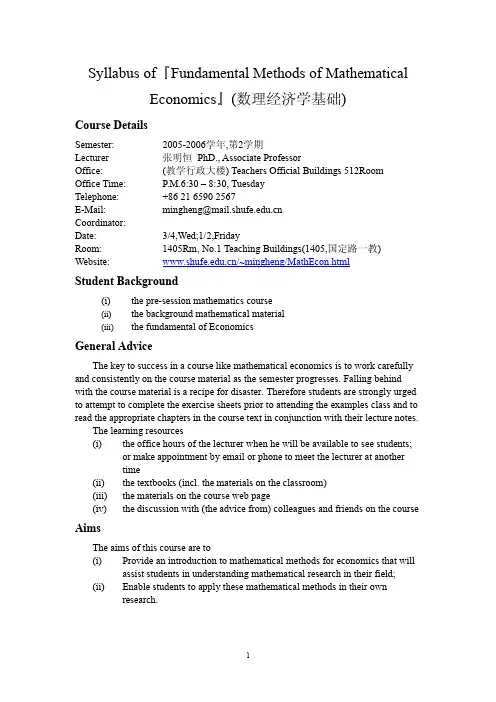
Syllabus of『Fundamental Methods of Mathematical Economics』(数理经济学基础)Course DetailsSemester: 2005-2006学年,第2学期Lecturer 张明恒PhD., Associate ProfessorOffice: (教学行政大楼) Teachers Official Buildings 512RoomOffice Time: P.M.6:30 – 8:30, TuesdayTelephone: +86 21 6590 2567E-Mail: mingheng@Coordinator:Date: 3/4,Wed;1/2,FridayRoom: 1405Rm, No.1 Teaching Buildings(1405,国定路一教) Website: /~mingheng/MathEcon.htmlStudent Background(i)the pre-session mathematics course(ii)the background mathematical material(iii)the fundamental of EconomicsGeneral AdviceThe key to success in a course like mathematical economics is to work carefully and consistently on the course material as the semester progresses. Falling behind with the course material is a recipe for disaster. Therefore students are strongly urged to attempt to complete the exercise sheets prior to attending the examples class and to read the appropriate chapters in the course text in conjunction with their lecture notes.The learning resources(i)the office hours of the lecturer when he will be available to see students;or make appointment by email or phone to meet the lecturer at anothertime(ii)the textbooks (incl. the materials on the classroom)(iii)the materials on the course web page(iv)the discussion with (the advice from) colleagues and friends on the course AimsThe aims of this course are to(i)Provide an introduction to mathematical methods for economics that willassist students in understanding mathematical research in their field;(ii)Enable students to apply these mathematical methods in their own research.ObjectivesAt the end of the course students should be able to(i) Demonstrate their understanding of the mathematical methods foreconomics;(ii)Understand and study Equilibrium Analysis, Comparative Statics Analysis, Optimization (multivariate), Dynamic Economic, Simultaneous Equations andLinear Programming etc.;(iii)Ready to advanced microeconomics, macroeconomics and econometrics.List of Readings1)Chuang,A.C., Fundamental Methods of Mathematical Economics,McGraw-Hill Publishing Company, 1984, 3rd Ed. (刘学译, 数理经济学的基本方法, 商务印书馆,2003年)(Text Book).2)Silbergerg, E., The Structure of Economics – A Mathematical Analysis,McGraw-Hill Education - Europe, 1990, 2nd ed, paperback.3)Klein,M.W., Mathematical methods for Economics, Addison-Wesley, 1998.4)Dowling,E.,T., Theory and Problems of Introduction to Mathematical Economics, 3nd5)Handbook of Mathematical Economics Vol.1-6,6)International Journal on Mathematical Economics such asi.Journal of Mathematical Economicsii.Journal of Economics Theoryiii.Journal of Economics and Businessiv.Journal of Mathematical Financev.Journal of Econometricsvi.Mathematical Social Sciencesvii.Economics Modellingviii.Economics Lettersix.Economics Theoryx.Game TheoryLecturesChapter 1 Nature of Mathematical Economics/数理经济学的实质Chapter 2 Economic Models/经济模型Chapter 3 Equilibrium Analysis in Economics/静态均衡分析,市场均衡模型,国民收入均衡模型Chapter 4 Linear Models and Matrix Algebra/线性模型与矩阵代数Chapter 5 Linear Models and Matrix Algebra/线性模型与矩阵代数,市场模型,国民收入模型,Leontief投入产出模型Chapter 6 Comparative Statics and the Derivative/比较静态分析,变化率/导数/曲率,极限定理,函数的连续性与可微性Chapter 7 Rules of Differentiation and Comparative Statics,微分法则,偏微分,Jacobi行列式Chapter 8 Comparative Statics of General Function Models,全微分/全导数,隐函数存在定理,一般函数模型的比较静态分析Chapter 9 Optimization (univariate),最优值与级值,导数检验,Maclaurin/Taylor 级数Chapter 10 Exponential and Logarithmic Functions/指数函数与对数函数,自然指数与增长问题,最优时间安排Chapter 11 Optimization (multivariate)/多变量的最优化,最优化条件的微分形式,二次型,目标函数,Hessian矩阵检验,函数的凹/凸性与极值问题,多产品厂商问题,价格歧视,投入决策Chapter 12 Optimization with Equality Constraints/具有约束方程的最优化,Lagrange Multiplier, Bordered Hessian Matrix检验,二阶条件效用最大化与消费需求,齐次函数/生产函数,投入最小成本组合Chapter 13 Economic Dynamics and Integral Calculus/动态经济学与积分学,动态与积分,定积分/不定积分/广义积分,Domar增长模型Chapter 14 First Order Differential Equations/连续时间的一阶微分方程,市场价格的动态过程,恰当微分方程,非线性微分方程Solow增长模型Chapter 15 Higher Order Differential Equations/高阶微分方程,复数,三角函数,复数根,具有价格预期的市场模型、通货膨胀与失业模型Chapter 16 First Order Difference Equations/离散时间的一阶差分方程,均衡的动态性,蛛网模型,具有存货的市场模型,非线性差分方程Chapter 17 Higher Order Difference Equations/高阶差分方程,Samuelson数乘加速模型,通货膨胀与失业模型Chapter 18 Simultaneous Differential and Difference Equations/联立微分和差分方程动态投入产出模型Chapter 19 Linear Programming/线性规划,单纯形SimplexChapter 20 Linear programming - cont./线性规划(续),对偶定理,活动的微观和宏观水平Chapter 21 Non-Linear Programming/非线性规划,Kuhn-Tucker定理,约束规范,Arrow-Enthoven定理Chapter 22 Game Theory / 搏弈论Chapter 23 1st Seminarspetitive Equilibrium Hyperinflation under Rational Expectations, Also see epge.fgv.br/portal/arquivo/1792.pdf2.Multiple Equilibria with Externalities,Also see/depts/econ/dp/0409.pdfChapter 23 2nd Seminars1.Dynamic Analysis of a Solow-Romer model of endgenous Economical GrowthAlso see .au/policy/ftp/workpapr/ip-68.pdf2.Seignorage, Productive Government Spending and Growth in a Lucasian General Equilibrium Model Also see /economics/staff/hmk/paper/HMKAW96.PDFSupplemental Materials for a ChoiceChapter 51)Leontief, Wassily W. “Input-Output Economics.” Scientific American, October1951, pp.15-21.2)Iris Jensen ,The Leontief Open Production Model or Input-Output Analysis3)Internet Resources for the Leontief Model/mathews/n2003/leontiefmodel/LeontiefModelBib/Links/LeontiefMo delBib_lnk_1.htmlChapter 71)The Financial Returns to Education2)Why Does’t Capital Flow to Poor Counters?, See Robert E. Lucas,Jr., American EconomicView, V ol.80,No.2,pp.92 – 96, 1990(May)Chapter 81)Growth Accounting,Cobb-Douglas Production Function2)The Division of national IncomeChapter 111)Properties of a Valid Cost Function2)Government Revenue3)Isabel Correia and Pedro Teles,The Optimal Inflation Tax4)Jens Suedekum, Profit maximization and firm supply under perfect competition,University of Konstanz,Chapter 121)Dan Segal, A Multi-Product Cost Study of the U.S. Life Insurance Industry, RotmanSchool of Management,University of Toronto2)Martin Feldstein, “College Scholarship Rules and Private Savings”, American EconomicReview, Vol.85, No. 3,pp. 552 –566(June, 1995)Chapter 131)Economics Growth modelChapter 141)Charles I. Jones, A Note on the Closed-Form Solution of the Solow Model2)Fadhel Kaboub, Long-run Keynesian Growth Theory: Harrod and Domar vs.Solow Chapter 151)Tor Jacobson, Johan Lyhagen†, Rolf Larsson and MarianneNessén,Inflation, Exchange Rates and PPP in a Multivariate Panel Cointegration Model, Sveriges Riksbank Working Paper Series No. 145,December 20022)Pierre L. Siklos, INFLATION AND HYPERINFLATION, Department of EconomicsWilfrid Laurier UniversityChapter 161)Money and Prices Model2)Philip Cagan “The monetary Dynamics of Hyperinflation”, Studies in the Quanlity Theory ofMoney, ed., Milton Friedman (Univ. of Chicago Press, 1956)Chapter 171)Nicholas Rau,Introduction to Growth Theory, University College London2)Economic Problems of Developing AreasChapter 181)The Dynamic Variable Input-Output Model: An Advancement From The Leontief DynamicInput-Output Model,Annals of Regional Science, Vol. 34, No. 4, January 20012)Obst,N.M., “Stabilization Policy with an Inflation Adjustment Mechanism,” The Quarterly,Journal of Economics, 92 (May 1978), pp.355-359Chapter 191)Linear programming2)/otc/Guide/OptWeb/3)Global Optimization4)http://www.fi.uib.no/~antonych/glob.html5)Tom Cavalier's Optimization Links/faculty/t/m/tmc7/tmclinks.html6)Optimization Center at Northwestern Univ.7)/OTC/8)Yinyu ye at Stanfod9)/~yyye/Chapter 201)J. J. H. Forrest and J. A. Tomlin,Implementing the simplex method for the OptimizationSubroutine Library, IBM SYSTEMS JOURNAL, VOL 31,NO 1, 1992ATTENDANCESince exams will test your knowledge of materials covered in class, you are expected to attend class. You are responsible for material covered in class (including changes in assignment or rescheduling the test) even if you are unavoidably absent.GRADING POLICYYour final grade will be based on your performance on two exams and homework and it will be determined as follows:Mid exam 15%Final exam 60%Homework 15%Class participation 10%Total 100%Your total will be converted into final course grade and plus and minus grading will be used in this course.。


